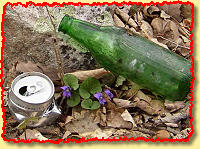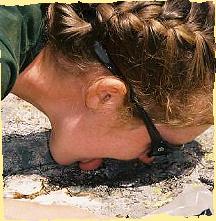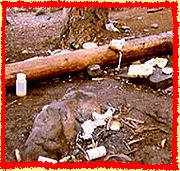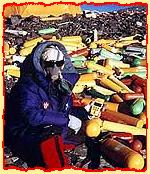
Dispose of Waste Properly

Give a Hoot - Don't Pollute. |
 Pack It In - Pack It Out
Pack It In - Pack It Out
There's really no reason to leave any waste behind when I visit the outdoors, other than human waste. All of the food and packaging that I take on the trail comes back home with me where it is disposed of properly. I used to burn paper in campfires and toss applecores out 'for the squirrels' but that was when I was a child and it was accepted disposal. Now, we know better.
This principle is basically guiding us to leave nothing in the wild when we return to our homes. Every bit of trash left behind builds up as more and more people visit an area. Garbage decomposes and, given enough time, bits of trash will disintegrate. But, the amount of time required may surprise you:
- Banana Peel - a month
- Paper - a couple months
- Wool Scarf - a year
- Cigarette Butt - 5 years
- Disposable Diaper - 2 decades
- Hard Plastic Container - 3 decades
- Rubber Boot Sole - 7 decades
- Tin Can - a century
- Aluminum Can - 3 centuries
- Plastic 6-pack Holder - 5 centuries
- Glass Bottles - eons
Decomposition of garbage is slower in alpine areas where there is less heat and moisture. Those bits of orange peel left behind might still be there a few years from now.
Reduce Trash First
By repackaging food into reusable containers before leaving home, the amount of potential trash can be nearly eliminated. Storing food in heavy-duty zip-loc bags reduces weight and waste and makes the packing more flexible. Packing all food for a meal into one container cuts down on confusion when figuring out what to unpack for dinner.
Reduce your plastic waste by using your own reusable water bottles.
Dispose of Food and Trash
- Pack out all garbage. Food does not burn completely in a campfire. Animals dig up buried food.
- Handle food carefully to eliminate dropped bits. Sunflower seeds, rice, Ramen noodles, bread crumbs are commonly dropped when a package is opened. Use a knife to carefully open a package inside a large plastic bag or over the cooking pot. If it isn't dropped, it doesn't need to be picked up.
- Only open and prepare food that will be eaten. Eliminate left-overs to prevent waste and reduce the garbage being carried out. Remember, uneaten food gets packed out too.
- Burn no trash - paper, aluminum, cardboard wrappers, and any packaging will not burn completely. Burning it will release contaminants into the air and soil. Tin foil, bottle caps, pop-tart wrappers and melted plastic are commonly found in firepits.
Dishes and Dishwater
Scrape all food out of dishes and either eat it or store it to pack out. There are very useful small plastic pot scrapers that get nearly everything off a pot or dish.
Wash dishes with hot water and a scrubbie, at least 200 feet from your campsite, trail, and water sources. Soap is not really needed for most cleaning. If you must use some, use a bit of biodegradable camp soap. Strain the dish water through a fine mesh screen or panty hose and into a container. The panty hose catches all but the tiniest of food bits and you can then pack them out in the garbage.
The resulting water is called 'grey water' and should be disposed of by broadcasting it over a wide area. That means throwing the water out in an arc to disperse it as much as possible. This helps it evaporate faster and reduces the attraction for animals.
 Dispose of Pee and Poop
Dispose of Pee and Poop
In most areas, peeing on the ground is acceptable. Try to go on mineral soil or rock so no vegetation is not damaged. The salt in the urine attracts animals which may further damage vegetation to get at the salt. Males are often advised to 'write their name' when they pee - this distributes the urine instead of concentrating it in one spot.
Make sure you go 200 feet away from camp, trail, and water sources.
Poop is more of a problem. The solid mass needs help from bacteria to break down so using a cathole is the most commonly accepted method of disposal.
Using a hand trowel, dig a 6 to 8 inch deep by 6 inch wide hole in soil or duff, carefully saving the top chunk of soil to replace where it was.
Do your business and then clean up. Dump some dirt in the hole and stir it into the poop with a stick to help start the decomposition. Fill in the rest of the hole and replace the top plug.
Either pack out used toilet paper or bury it deep in the cathole. Toilet paper is often left exposed and is an eyesore. Burning toilet paper is no longer an accepted disposal method due to it blowing away and causing wildfires as well as not burning the waste completely.
Pack Out Human Waste
Above treeline, there is seldom adequate ground soil in which to dispose of waste. The regulations at some popular locations require packing out human waste due to the massive volume. These tend to be wild areas that receive high traffic. Mt. Whitney is a good example. There are waste pack-out kits available to make it very easy to carry out your waste. They have odor-fighting chemicals or natural ingredients with liquid-absorbing powder in double-bag containers. By using these kits, you take care of the last trace we tend to leave behind. It's actually good practice to use them whenever you visit wild areas.
Do-It-Yourself pack-out kits are another solution. Put some kitty litter in a paper bag. Roll the top closed and put this along with a few sheets of toilet paper in a heavy-duty zip-loc baggie. Deposit the feces and used toilet paper in the paper bag, roll it closed, seal it in the baggie, and carry it out. Dispose of the paper bag in an outhouse, septic tank, or RV waste facility - but not the plastic baggie.
Feminine hygiene products should always be packed out.
Tips on Waste Disposal
- Never bring glass on the trail. It is heavy, easily broken, dangerous, and does not break down.
- Protect your food and trash in bear-proof containers or bear-bags.
- Pick up trash from others as well as your own - you have extra space from the food you ate. - LEAVE LESS TRACE
- Carry your food in heavy-duty zip-loc bags and carry the trash out the same way. You can reuse food bags as garbage bags the next trip.
Disposing of Waste Properly is Important because it:
- improves sanitation in highly trafficed areas
- protects water supplies
- encourages others to reuse established, clean campsites
- prevents habituation of animals, which protects both the animals and visitors
Examples To Consider
 | This hiker dripped some jelly while making a sandwich at lunch. Rather than leaving it there, she licked it off the fairly clean rock. If it had been dirt, she might have wiped it up with a napkin and packed it out. |
| As a campsite becomes more and more popular, small impacts quickly accumulate. Some people see garbage and then feel they do not need to take care since it's already trashed. Taking a bit of extra time to clean up a spot will help keep it cleaner. The next visitors will see no trash and tend to pack out their own trash. Even highly trafficked sites can be made more inviting by removing trash and cleaning out old fire debris. |  |
 |
Taking the extra bit of effort to patrol the campsite just before leaving often finds bits of foil, plastic, and food from your group or others before you. This guy has the right idea and is making the site as inviting as possible for the next visitors. Even though this site gets so much traffic there is nothing growing, he is making sure the floor is clean and cleared. |
|
No matter where you go, if people have been there, people have left litter. Whether on the ocean shore or on the highest peak in the world, when it is more convenient to leave trash than take it away, someone will decide to leave it. When climbing Everest and other mountains, climbers often leave behind oxygen canisters, tents, and all sorts of gear. This is usually due to emergency situations, but sometimes simply from lack of concern. The same thing can happen on simple backpacking trips. If plans for bad weather and extremes are not made adequately, groups will sacrifice Leave No Trace practices for safety. |  |
Debate the Principle
There may be reasons to make different choices when considering this Leave No Trace principle. Here are a few to think about:
- Repackaging food consumes more plastic. The weight and bulk carried into the wild is reduced but more overall trash is created. Some people may choose to carry the extra weight.
- Some Pack-Out Kits create more waste if they include chemicals and plastics. Cat hole may be preferred, especially in low-traffic areas.
- Burning of paper trash may still be considered acceptable by some management agencies and many wilderness users.
Teaching Dispose of Waste Properly
- General Teaching Advice - good ways to get people to learn
- Activity - The Little Things
- Activity - Food Scraps
- Activity - Cat Holes
- Activity - Pack Out Kits
- Activity - How Long Will It Last?


